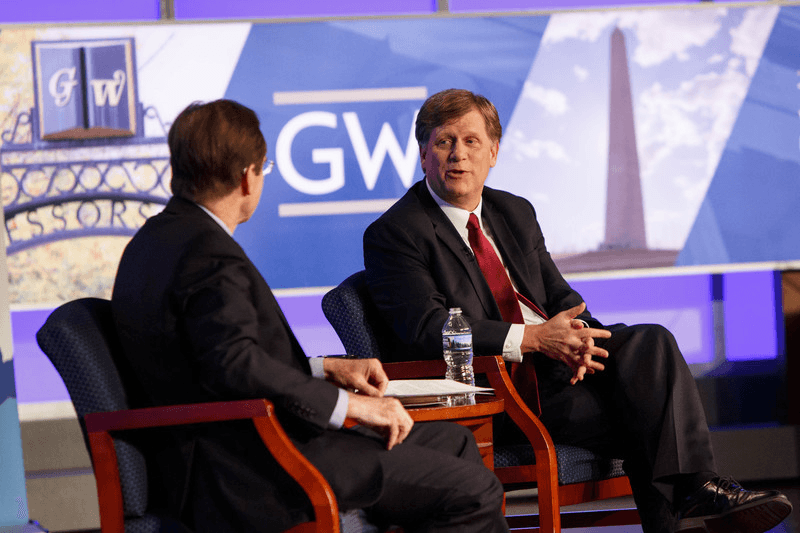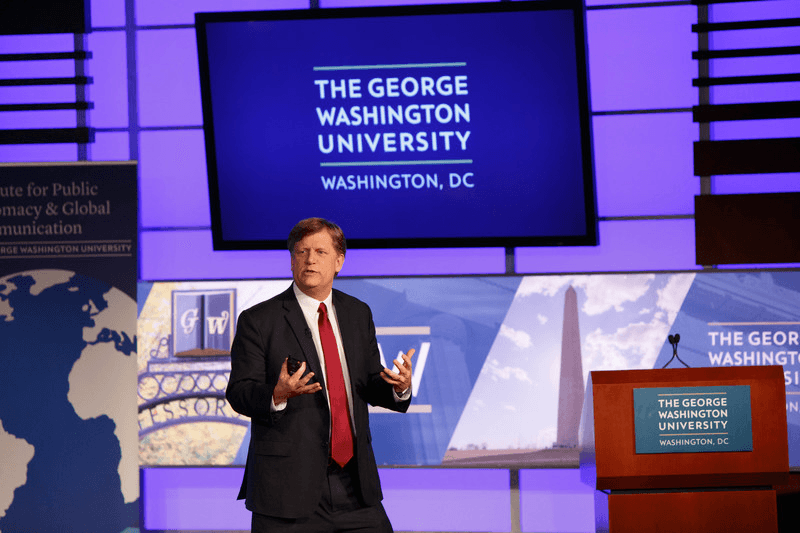Just a day after Attorney General Jeff Sessions recused himself from any investigations into the Trump’s campaign contact with Russia, the Institute for Public Diplomacy & Global Communication partnered with the Walter R. Roberts Endowment to host a lecture and Q & A with former ambassador to Russia, Michael McFaul. McFaul’s lecture explored what had ignited the U.S.’ new Cold War with Russia – and what had changed after nearly 30 years of relatively constructive relations. In his lecture, McFaul outlined three possible explanations for the faltering relationship and Russia under Vladimir Putin.

We cannot blame international politics
Firstly, McFaul discussed why the inherent structure of international politics doesn’t account for Putin’s interest in expansion or the strained relationship the U.S. has with Russia now.
“There’s this idea that this is just a natural correction. That Russia is a great power and is acting like a great power,” McFaul said.
But if that were the case, that Putin being more aggressive is just a natural correction, a similar pivot would have happened with Japan and Germany after World War II. At that time, great powers had fallen, but with U.S. aid and investment in each country’s ability to establish a democratic government, each country became a global power without becoming aggressors towards the U.S. If Russia were simply building up to become a major power again after the fall of the Soviet Union, there wouldn’t be a need for a strained relationship between the U.S. and Russia. Instead, perhaps the two countries could have worked together to establish a stronger democracy in Russia. According to McFaul, an error the U.S. made was not investing enough in Russia after the Soviet Union collapsed.
Up until 2013, the world seemed to think that Russia was just becoming a more mature, global power. It wasn’t until Putin’s plans shifted so wholly that the rest of the world started to take notice that Russia was becoming an aggressor, not a peaceful power.
But it wasn’t until 2013 that the rest of the world started seeing a real shift in Putin’s plan. In 2013, Putin was concerned with the Eurasian Economic Union. He wanted the Ukraine to come on board with the EEU, rather than join the West to make the union large enough to be sustainable. Furthermore, up until 2013, Putin seemed to be going in a positive direction on the world stage mostly because of the olympics. The Sochi Olympics was Russia’s time to export a “new Russia” to the rest of the world. Putin’s administration reclaimed authors and artists that were excommunicated during the Soviet Union, and presented Russia as an inclusive country.
“They released Khodorkovsky. [Russia was] essentially saying, ‘We’ve had a rocky space. This is a signal to you, the United States, to have a new relationship with us’,” McFaul said.
Soon after the Olympics’ closing ceremony ended, though, Putin invaded Crimea.
If international politics was the real reason the new Cold War began, it would have started far before Putin decided to invade Crimea because simply the idea of Russia becoming a great power isn’t a threat to the world order or balance of power.

And it’s not U.S. Policy
Another theory McFaul was quick to dismiss is that Russia has to be aggressive towards the United States because U.S. foreign policy pushed it into a corner. But to Putin, the U.S. seemed to be an emerging threat around in the early 2000s and into 2013. NATO’s expansion, the U.S.’ invasion of Iraq, the NATO bombing in Serbia in 2013 and U.S. support for color revolutions all could have been perceived as Western aggression towards Russia. According to this theory, “We are too demanding of Russia, we were lecturing them, we support color revolutions. Putin had enough and his actions are a reaction to what we did”.
However, after these perceived threats the U.S. and Russia began a reset designed to be a win-win relationship between the U.S. and Russia – the idea was that through a strategy of active engagement, the U.S. and Russia would find common interests to strengthen both countries. It is important to note that at the time of the reset, Medvedev was president, and seemed more open to more open relations with the U.S. According to McFaul, this worked for the most part. The new START treaty was put into force in February 2011, and it called for nuclear limits on both countries, eighteen on-site inspections of both countries and no constraints on missile defense or conventional strikes. During the reset, the Iran deal was also signed, which worked in both the U.S. and Russia’s interest to stop Iran from developing a nuclear weapon. Furthermore, the reset also included the Northern Distribution Network (NDN), which supplied material to forces in Afghanistan in a combined effort on the war in Afghanistan.
“At the height of the reset, sixty percent of Russians had a positive view of Americans, and sixty percent of Americans had a positive view of Russians. That was five years ago,” McFaul said.
U.S. policy aided Russia during the reset – and it showed in approval ratings. The economies of both countries were steadily rising and there was more support of American-Russian relations than had been in years. If U.S. policy were to blame, how could one explain all of the positive developments in the relations after the perceived threats? According to McFaul, there is only one last narrative that could explain today’s tensions.
Russian Domestic Politics – it starts at home
When power shifted from Medvedev to Putin, the U.S. incorrectly thought that nothing should really change, according to McFaul.
“We all knew that Putin was doing everything behind the scenes anyway. We didn’t think anything would change,” McFaul said.
However, internal pressures created Putin’s aggressive pivot towards the West because he needed someone to blame the conflict on. Putin saw the U.S. supporting the revolutions in Egypt and Libya – and in his view in Russia too. Putin viewed demonstrators as traitors. Once Putin’s ally and Ukrainian leader Yanukovych fell in 2014, Putin pivoted completely against the U.S. as he saw U.S. ideology threatening his reign. The demonstrations in the Middle East and in Russia between 2011 and 2012 forced Putin to try and look stronger in his own country.
“The good news is, I don’t think Putin has a master plan to recreate the Soviet Union,” McFaul said. “There’s no evidence that that’s what he’s doing. The bad news is that Putin’s not changing. He can be in power legally until 2024, and Putin needs an enemy.”
As long as Putin feels threatened by revolutions and demonstrations in his own country and in those immediately surrounding Russia, the U.S. will continue to be his enemy. And, according to McFaul, a Trump presidency that is friendlier towards Russia won’t do much to change that.
Trump’s hothead meets the Cold War
Trump speaks about Russia as if the goal is to be Russia’s friend, McFaul theorized, and that could backfire.
According to McFaul, President Trump was confusing goals with means. “The job of a diplomat is to represent your country’s interest in another country. Not to be that country’s friend,” McFaul said.
Because of the Trump Administration’s recent controversies, like Sessions’ recent recusal and Russia’s interference in the 2016, Trump will have difficulty making any headway in Russia–U.S. relations. As of now, it might be politically impossible for Trump to grant any significant concessions to Russia without the exchange looking like political favors.
Furthermore, according to McFaul, there’s not much Russia can give us in negotiations.
“They could lift the ban on adoptions, but on bigger things I’m less optimistic. Our overlapping interests are much smaller than they used to be,” McFaul said.
Unfortunately, it looks like the new Cold War won’t be ending any time soon. But according to McFaul, it’s important to realize that a powerful Russia shouldn’t be a fear. Rather, the more pressing need is to reduce the idea that the U.S. is Russia’s enemy, and that they are ours.
Caveat: The views expressed in this blog are the author’s own and do not necessarily reflect those of the Institute for Public Diplomacy and Global Communication or the George Washington University.


This is a really great summary of McFaul’s refreshing take on U.S.-Russian relations! The tension between our nations rarely lends itself to a conversation wherein part of the blame is assigned to U.S. failure to help Russian cope after the collapse of the Soviet Union. Just wondering, is the term “a new Cold War” something you came up with or something that McFaul coined during this event?
I really enjoyed reading your summary of the event. There are clearly many factors that go into successful relations with other countries. I’d be interested to know your thoughts in reaction to what McFaul said. Do you agree with his reasoning?
Good summary. While McFaul does leave the door open to cooperation with action-orientated initiatives like the SMART treaties, he seems to suggest that larger, systemic narratives about world order represent a greater impasse for the US and Russia. The idea that perception sometimes matters more than truth itself came up a lot for me throughout this article. In this report from the Center for Strategic and International Studies, Russia’s perception of the American military threat is further explored. It’s worth checking out if the topic interests you: https://www.csis.org/analysis/russia-and-%E2%80%9Ccolor-revolution%E2%80%9D
This was a good summary of Ambassador McFaul’s lecture. You covered all of the important points in detail. I am interested in your usage of “the Ukraine” in your post as opposed to just “Ukraine.” “The Ukraine” was the term used to refer to a part of the USSR, whereas “Ukraine” refers to the state. I am curious if Ambassador McFaul referred to Ukraine this way in his talk. Here is a Time article about the usage of “The Ukraine” today: http://time.com/12597/the-ukraine-or-ukraine/